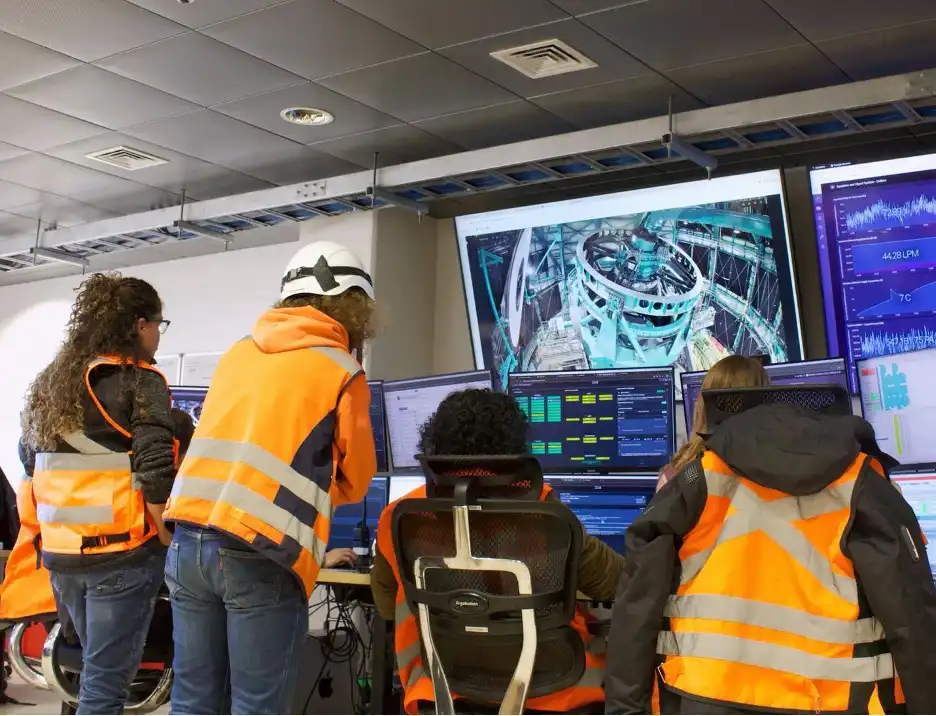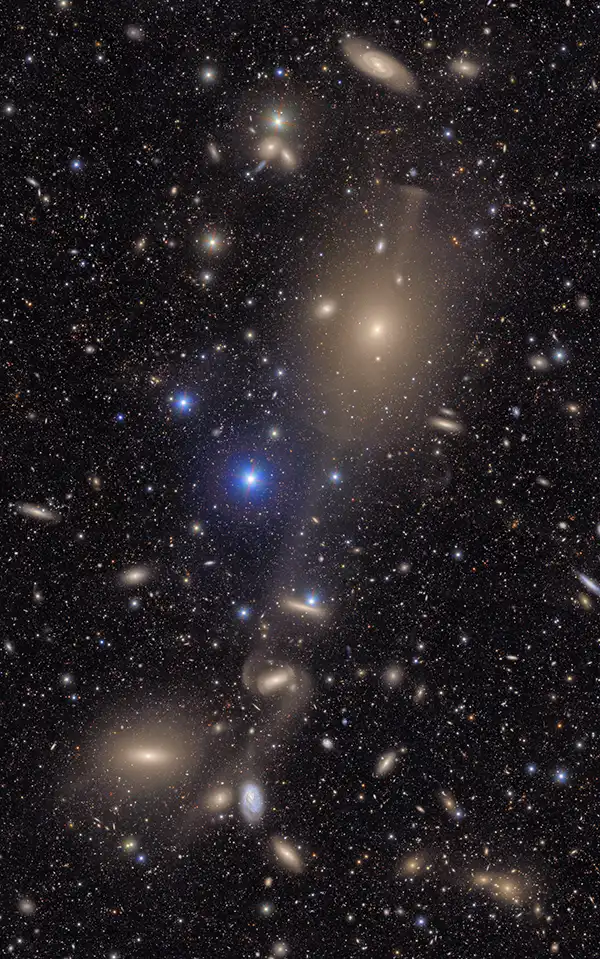We’re now seeing the first images after years of effort and frantic last-minute fixes that pushed the new observatory to completion.
 The night sky dazzles over Rubin Observatory in this shot from October 2024. The Milky Way sprawls overhead in the waning light of sunset. Venus shines brightly on the left, while Comet C/2023 A3 (Tsuchinshan–ATLAS) appears just above the observatory at center.
The night sky dazzles over Rubin Observatory in this shot from October 2024. The Milky Way sprawls overhead in the waning light of sunset. Venus shines brightly on the left, while Comet C/2023 A3 (Tsuchinshan–ATLAS) appears just above the observatory at center.
H.Stockebrand / RubinObs / NOIRLab / SLAC / DOE / NSF / AURA
At the summit of Cerro Pachón, the Chilean mountain home to the newly constructed Vera C. Rubin Observatory, fatigued yet focused scientists gather in the observatory’s control room. They’re monitoring the telescope’s systems while waiting to troubleshoot a problem that has been plaguing them: The telescope’s camera is overheating, just weeks before the observatory is set to release its first images to the public.
Those images, now unveiled during a June 23rd “first look” event, are just the beginning. Every three nights for the next 10 years, the fast-moving and unprecedentedly sensitive telescope will complete a scan of the Southern Hemisphere’s sky, generating 60 million gigabytes of data. Eventually, those scans will help create a time-lapse “movie” of the universe known as the Legacy Survey of Space and Time (LSST). Its goals include demystifying dark matter and dark energy, catching fast-moving or ever-changing objects in the night sky, and mapping the universe around us.
 This image, one of the first to be taken by the Vera C. Rubin Observatory, combines 678 exposures, totaling a little more than seven hours of observing time. Combining many images in this way clearly reveals otherwise faint or invisible details, such as the clouds of gas and dust that comprise the Trifid Nebula (top right) and the Lagoon Nebula (center), both of which are several thousand light-years away from Earth.
This image, one of the first to be taken by the Vera C. Rubin Observatory, combines 678 exposures, totaling a little more than seven hours of observing time. Combining many images in this way clearly reveals otherwise faint or invisible details, such as the clouds of gas and dust that comprise the Trifid Nebula (top right) and the Lagoon Nebula (center), both of which are several thousand light-years away from Earth.NSF / DOE / Vera C. Rubin Observatory
But taking these initial images is no small feat. Since construction began in 2015, highly customized components built in labs around the world have been coming together on the remote mountaintop, with technical problems solved on-site.
“The last month was a crazy month, working very hard,” Fernanda Urrutia, an astrophysicist working on Rubin’s education and public outreach team, tells me soon after I arrive at the summit. The scientists’ work during my visit is focused on trying to fix the cooling systems for the Rubin digital camera, the largest in the world.
 For months before the First Look press conference, scientists have been hard at work in Rubin’s summit control room, making sure the telescope (pictured on screen) is ready to begin its 10-year survey of the cosmos.
For months before the First Look press conference, scientists have been hard at work in Rubin’s summit control room, making sure the telescope (pictured on screen) is ready to begin its 10-year survey of the cosmos. K.R. Callaway
The cooling systems have always been “the big pickle” for engineers working on the LSST Camera, says research engineer Claire Juramy (French National Institute of Nuclear and Particle Physics). Different parts of the camera need to be kept at different temperatures and, if any of their separate cooling systems malfunction, the camera can overheat relatively quickly. So, when on-site scientists saw the camera’s temperature climbing even as the outside air temperature dropped in the middle of the night, they were quick to shut it down and start problem-solving.
“Admittedly, there is not a good understanding of the situation today,” Kevin Fanning, a member of the commissioning science and camera teams, told me the morning I arrived in early May. But Fanning and the rest of the group on-site did not seem bogged down by this uncertainty — even so close to taking the first images. Shutting down the camera provides a great opportunity to conduct engineering tests they can’t do while actively observing the sky. “It’s definitely stressful, but I love these days,” Fanning added.
By evening, the temperature graphs on the screens in the summit control room were stabilizing, and engineers established a plan for the night. They would wait until the outside temperatures dropped again before operating the camera to determine if the cold air outside was responsible for the cooling system’s malfunction. This test was expected to be a slow one, and some of the observing scientists settled around to play Uno as night fell on the mountain.
But behind us, the many graphs on screen suggested the outside temperature was not falling at all — it was getting hotter. “Weather forecasts for mountaintops are notoriously difficult to do,” Fanning explains. As it became clear they would have to wait another night to complete the test, the scientists recounted the camera’s installation in March.
 This image shows a small section of the Virgo galaxy cluster, which lies about 50 million light-years away. In the foreground, bright stars in our own galaxy shine, while much more distant galaxies are in the background.
This image shows a small section of the Virgo galaxy cluster, which lies about 50 million light-years away. In the foreground, bright stars in our own galaxy shine, while much more distant galaxies are in the background.NSF / DOE / Vera C. Rubin Observatory
The camera had to be placed at just the right place relative to the primary and secondary mirrors to capture in-focus images. “By dead reckoning, we placed this camera within maybe three millimeters [of where it should be],” says Robert Lupton, who works with scientific software at Rubin as the LSST’s pipeline scientist. But with such a wide field of view, even with the camera just slightly out of place, the engineering images turned up donuts of light where there should have been stars. Those images provided the information needed to tweak the camera’s placement until it was just right.
Slow and steady seems to do well as a guiding principle for the observatory. The same principle applies to fixing the cooling system, notes Aaron Roodman (Stanford University), who leads the camera team. “Take a step and then discuss,” he advises the others via video call the next morning as they formulate a new plan.
It turns out the cold night air was involved. In the following weeks, the team further insulates the cooling systems and explories heating options to keep parts of the camera warm on cold nights. The fixes bring the observatory one step closer to the first-look images.
 This image shows another small part of the Virgo cluster. Visible are two prominent spiral galaxies (lower right), three merging galaxies (upper right), several groups of more distant galaxies, many stars in the Milky Way Galaxy, and more.
This image shows another small part of the Virgo cluster. Visible are two prominent spiral galaxies (lower right), three merging galaxies (upper right), several groups of more distant galaxies, many stars in the Milky Way Galaxy, and more.NSF / DOE / Vera C. Rubin Observatory
Now, those images showcase the observatory’s potential. Focusing on small patches of the sky full of galaxy clusters and nebulae, they show not only how deeply the camera can gaze into the universe but also give a taste of how many objects there still are to discover and understand. The full survey of the Southern Hemisphere sky is slated to begin later this year.
In Chile, the celebrations are just one more step in the continuing collaborative process of getting the high-profile observatory up and running.
The reporting for this article was partially supported by a grant from the National Science Foundation.
.png)




